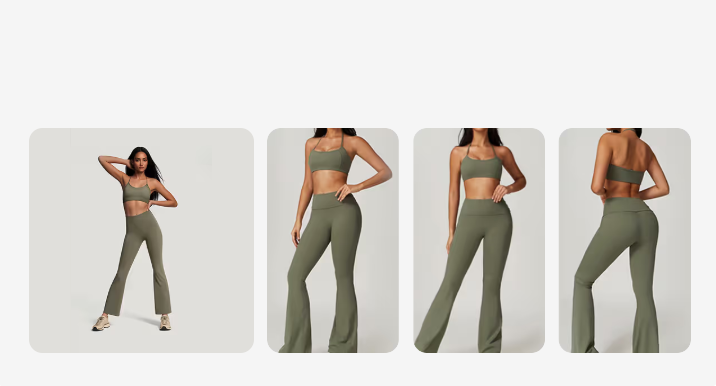In today’s digital age, the world of fashion e-commerce is evolving rapidly. With more consumers opting for online shopping over traditional retail experiences, fashion brands face the challenge of delivering an engaging and personalized shopping journey. This is where virtual try-on solutions come into play. By leveraging AI-powered technology and augmented reality (AR), fashion brands can offer customers the chance to try on clothes virtually, revolutionizing the online shopping experience and addressing some of the biggest challenges in e-commerce today.
Virtual try-ons are no longer a luxury for fashion e-commerce but a necessity for staying competitive. Here’s why virtual try-on solutions are essential for fashion e-commerce success.
Enhancing the Customer Shopping Experience
How Virtual Try-Ons Improve User Experience
A seamless shopping experience is vital for keeping customers engaged and coming back for more. Virtual try-ons provide a more immersive and personalized shopping experience that traditional images cannot replicate. Consumers are more likely to make a purchase when they can see how clothing fits their body, especially when they can interact with the product in a dynamic and real-time environment. This type of interactive shopping experience is crucial in retaining customers and enhancing their shopping satisfaction.
Unlike traditional static images, virtual fitting rooms allow customers to try on clothes virtually, giving them a more accurate and enjoyable representation of how the product will look on them in real life. Augmented reality provides real-time simulations of fashion items on a customer’s body, making them feel like they are trying on outfits in an actual store.
Building Confidence in Online Purchases
One of the biggest challenges in online fashion shopping is the uncertainty of fit. Virtual try-on solutions help customers see how clothes fit and move with their body, significantly reducing the risks associated with online purchases. With the ability to try on clothes virtually, shoppers are able to visualize what the clothing will look like before committing to a purchase. This leads to increased confidence and fewer purchase hesitations.
When customers are confident that the clothing will fit and look good on them, they are more likely to make a purchase. This not only improves conversion rates but also reduces the anxiety that often accompanies online fashion shopping, thus increasing customer satisfaction.
Reducing Returns and Boosting Revenue
Virtual Try-Ons: A Solution to High Return Rates
Returns are one of the most significant challenges in the fashion industry. Size and fit issues are the leading cause of returns, and they are a drain on both retailers’ finances and the environment. By allowing customers to try on clothes virtually, fashion e-commerce businesses can reduce returns by ensuring that customers purchase items that fit them properly the first time.
AI-powered virtual fitting rooms allow customers to see how clothes will fit on them, eliminating the uncertainty that leads to returns. When customers can confidently select the right size and style, they’re more likely to keep the products they purchase, which not only reduces the number of returns but also boosts retailer profits.
Increasing Customer Loyalty and Lifetime Value
The impact of virtual try-on solutions extends beyond initial purchases. When customers have a positive experience trying on clothes virtually, they are more likely to return to the brand in the future. Virtual try-ons offer a high level of engagement that creates a memorable shopping experience, which translates into higher customer retention rates.
Incorporating AI-powered virtual fitting rooms fosters stronger customer relationships by providing a personalized shopping experience. When consumers feel that their preferences are understood, they’re more likely to engage with the brand, sign up for loyalty programs, and make repeat purchases, leading to higher lifetime customer value.
Improving E-Commerce Conversion Rates
How Virtual Try-On Technology Increases Conversions
Virtual try-ons are a proven way to boost conversion rates in the fashion e-commerce world. According to multiple studies, online shoppers are more likely to complete a purchase when they feel confident about the fit and appearance of the products they are buying. By enabling customers to virtually try on clothes, retailers can increase customer engagement, which in turn leads to more purchases.
The interactive nature of virtual try-ons encourages users to spend more time on product pages and explore different outfit combinations. As they experiment with various looks, they are more likely to purchase multiple items, resulting in increased average order value (AOV) and higher overall sales.
Future-Proofing Your Fashion E-commerce Business
Staying Competitive in the Digital Age
As fashion e-commerce becomes increasingly competitive, brands need to innovate and offer unique solutions that attract and retain customers. Virtual try-on technology facilitating Swap Fashion Model, Instruct Edit and other for an essential future-proofing tool that allows fashion brands to stay ahead of the curve because it provides . As consumer expectations evolve, offering cutting-edge solutions like virtual try-ons can provide a competitive advantage over brands that haven’t yet embraced these innovations.
Adopting virtual fitting rooms positions brands as tech-savvy leaders in the fashion industry. It sends a message to consumers that the brand is committed to offering the most convenient, personalized, and user-friendly shopping experience possible. This helps build brand credibility and attract the next generation of consumers who expect the best in fashion technology.
The Technology Behind Virtual Try-Ons
How AI and Augmented Reality Work Together
Virtual try-on technology relies on a combination of AI and augmented reality (AR) to create an engaging and realistic shopping experience. AI algorithms analyze a customer’s body shape and measurements to generate a 3D model, while augmented reality overlays digital garments onto this model in real-time. The result is a dynamic and accurate representation of how clothing will look and fit, helping the customer make an informed decision.
This interactive experience helps to bridge the gap between traditional in-store shopping and online shopping, providing customers with the best of both worlds.
FAQs
Q1: What is virtual try-on technology?
A1: Virtual try-on technology uses AI and augmented reality (AR) to allow consumers to try on clothes virtually. It overlays digital clothing on a customer’s photo or 3D model to show how the garments will fit and look.
Q2: How does virtual try-on technology work?
A2: Virtual try-on technology works by analyzing a customer’s body shape and measurements using AI algorithms. The system then uses augmented reality to display clothing on a virtual model, allowing the customer to see how the clothing fits before making a purchase.
Q3: How can virtual try-on technology reduce returns in fashion e-commerce?
A3: By allowing customers to see how clothes fit and look before purchasing, virtual try-on technology reduces the uncertainty that leads to returns. This ensures that customers buy the right size and style, reducing the number of returns due to fit issues.
Q4: Can virtual try-ons help increase conversion rates?
A4: Yes, virtual try-ons lead to higher conversion rates because customers are more likely to buy when they are confident about the fit and style of the products they are purchasing. The interactive nature of virtual try-ons encourages more engagement, which results in more purchases.
Q5: What are the benefits of virtual try-ons for fashion retailers?
A5: Virtual try-ons offer numerous benefits for fashion retailers, including increased conversion rates, reduced returns, and improved customer satisfaction. They also help retailers provide a more personalized and innovative shopping experience that attracts and retains customers.
Q6: How does virtual try-on technology work in fashion e-commerce?
A6: In fashion e-commerce, virtual try-on technology uses AI to create a digital model of the shopper based on their body measurements or photo, and augmented reality to simulate how the clothing will look. Customers can try on clothes virtually before buying.
Q7: Can virtual try-on technology be used for all types of clothing?
A7: Yes, virtual try-on technology can be used for a wide variety of clothing items, including dresses, tops, shoes, and accessories. Some platforms also specialize in specific categories like eyewear or footwear.
Q8: How does virtual try-on technology help improve sustainability in fashion?
A8: Virtual try-ons reduce the number of returns, which helps lower the carbon footprint associated with shipping and packaging. This contributes to a more sustainable fashion industry by minimizing waste and unnecessary production.
Q9: How can fashion retailers integrate virtual try-on technology?
A9: Fashion retailers can integrate virtual try-on solutions by partnering with AI-powered platforms that offer API integrations. These platforms can be easily incorporated into e-commerce websites or mobile apps to provide a seamless shopping experience.
Q10: How does virtual try-on technology improve customer loyalty?
A10: By offering a personalized and interactive shopping experience, virtual try-on technology builds trust with customers, leading to increased satisfaction and repeat purchases. It provides a memorable shopping experience, which encourages customers to return to the brand.



